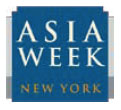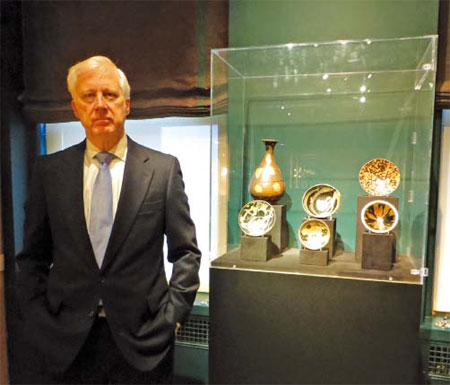New York's immersion in Asian Art
Updated: 2013-03-15 12:00
By Kelly Chung Dawson in New York (China Daily)
|
||||||||

|
Top: James Lally (left), J. J. Lally & Co Oriental Art gallery founder, presents articles from the Ronald W. Longsdorf Song Dynasty Ceramics collection for members of the press for Asia Week. The nine-day event includes exhibitions, auctions and special events presented by 43 leading international Asian art specialists, five major auction houses, and 17 museums and cultural institutions in various venues throughout metropolitan New York. From Below: Zhu Daoping's Autumn View (2011), painting with ink and mineral pigments on Xuan paper at the Chinese Abstraction Now exhibit at M. Sutherland Fine Arts. A snuff bottle on display for the Treasured Objects of Contemplation exhibition curated by the Los Angeles-based Asian Art Studio. Zhu Jinshi's Small Painting Mid-2007 oil on canvas artwork on display at M. Sutherland Fine Arts. Chen Wenling's 25-inch tall bronze sculpture, Pig, is on display at M. Sutherland Fine Arts. Photos by Caroline Berg / China Daily |


Marking its fifth year, today Asia Week New York kicks off an eight-day celebration of Asian art that will offer specially-curated exhibitions of Asian artwork at 43 galleries, in tandem with five major auction houses and 17 museums and cultural institutions. On display will be paintings, ceramics, bronzes, sculptures, photographs, textiles and jewelry from across Asia.
"Asia Week launched in response to the growing dynamism and interest in Asian art in the New York market, because it became clear that groups in the art world needed to gather together to provide a focal point for all the interest and activity," said Henry Howard-Sneyd, chairman of Asia Week New York and Sotheby's vice-chairman of Asian Art in America. "This is an effort to coordinate the many different dealers and institutions and auction houses into a single week of activity that is attractive and convenient for people who are not only in New York, but for clients who travel from around the world to attend."
The annual event has seen an uptick in both visitors and participants, with an increase of 25 percent in participating galleries since last year, Howard-Sneyd said. Most of the exhibition spaces will display their own pieces, but a number of galleries from Europe and elsewhere in the US will rent space specifically for Asia Week New York. Many spaces will also offer lectures and symposia elaborating on their displayed items, according to organizers.
"This week galvanizes a lot of the interest in the country, because it draws people who know they're going to see not one, but 40 exhibitions which relate to Asian art," said Conor Mahony, curator at the Chinese Porcelain Company, which will be participating in the celebration. "It's a chance for curators to come and spend one week to see what's being represented in the market, and that's important."
Among the many exhibitions on display during Asia Week New York are Chinese Porcelain Company's "Magnificence Within: New Ink Paintings," which will feature 15 new works by the contemporary ink painter Tai Xiangzhou; "From Curiosity to Devotion," at the Fuller Building, featuring an array of Chinese snuff bottles dating to the 1800s; and "Song Dynasty Ceramics: The Ronald W. Longsdorf Collection," at J.J. Lally & Co, which will display vases, tea bowls and other vessels.
Although it's difficult to monitor exact numbers of visitors to the week's events, visa request letters from buyers in China who are interested in attending the event have also increased in numbers since the event's launch five years ago, Howard-Sneyd said. Organizers reportedly received several hundred visa requests from Chinese citizens this year.
In fact, buyers in China are increasingly affecting the US market for Asian art, Mahony said.
"Chinese interest has driven prices up beyond discretionary limits," he said. "A piece that would have sold for $50,000 10 years ago is now often above $100,000, which is beyond some people's price limits in the US."
James Lally, founder of the gallery J.J. Lally & Co and former president of Sotheby's North America, also reported a dramatic rise in the numbers of Chinese buyers. Economic success in the region has led to a growing class of buyers with both the funding and the leisure time to travel and acquire Chinese art, he said. Although American and European buyers are still a significant part of the market, the balance has shifted toward Chinese buyers.
Regarding the recent downturn in the Chinese art market, he cautions against placing too much weight on the spikes and lulls of individual sales categories, he said.
"What happened was Chinese art was dramatically undervalued for many years, and considered esoteric and unintelligible, so when that changed, prices accelerated much faster than ever seen before," he said. "It's natural that it couldn't continue to accelerate at the same rate."
Howard-Sneyd speculated that the change in Chinese leadership in 2012 also led buyers to hold off on purchasing art.
Interestingly, Chinese and Western buyers of Asian art seem to lean toward the traditional, a preference that is reflected in the selections on display this week. Although a number of galleries (including M. Sutherland, which will be displaying an exhibition of abstract paintings) are featuring work by contemporary artists, the selected items are from the Asian medium of ink painting, as opposed to Western oil painting.
This reflects the demands of the New York market, Howard-Sneyd said. Dealers and auction houses with a focus on Asian art have prioritized more traditional forms of Chinese art, whereas contemporary Chinese art of Western media, such as oil painting, have generally been viewed as being of interest to dealers with a more broad focus on contemporary art, Lally said.
Although Asia Week New York is considered a must-see for high-level collectors and museums, the event also has something to offer for amateur collectors and people with only a glancing knowledge of Asian art, Lally said.
"The best way to learn about art is to see and handle as many examples of the type of art you're interested in, as possible," he said. "Direct contact with people who are interested and excited about Asian art produces a learning experience and level of participation that is not possible anywhere else."
More information about Asia Week New York's various activities is available at www.asiaweekny.com; the event ends March 23.
kdawson@chinadailyusa.com
(China Daily 03/15/2013 page10)

 In Photos: 7.0-magnitude quake hits Sichuan
In Photos: 7.0-magnitude quake hits Sichuan
 Li Na on Time cover, makes influential 100 list
Li Na on Time cover, makes influential 100 list
 FBI releases photos of 2 Boston bombings suspects
FBI releases photos of 2 Boston bombings suspects
 World's wackiest hairstyles
World's wackiest hairstyles
 Sandstorms strike Northwest China
Sandstorms strike Northwest China
 Never-seen photos of Madonna on display
Never-seen photos of Madonna on display
 H7N9 outbreak linked to waterfowl migration
H7N9 outbreak linked to waterfowl migration
 Dozens feared dead in Texas plant blast
Dozens feared dead in Texas plant blast
Most Viewed
Editor's Picks

|

|

|

|

|

|
Today's Top News
Live report: 7.0-magnitude quake hits Sichuan, heavy casualties feared
Boston suspect cornered on boat
Cross-talk artist helps to spread the word
'Green' awareness levels drop in Beijing
Palace Museum spruces up
First couple on Time's list of most influential
H7N9 flu transmission studied
Trading channels 'need to broaden'
US Weekly

|

|








